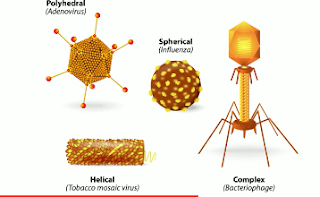What does the Common cold, the flu, measles, and chicken pox, all have in common?
They are diseases caused by a virus.
Viruses are found almost everywhere on Earth. They can infect animals,plants,fungi, protists and even bacteria. Viruses are not classified as prokaryotes or eukaryotes. They are much smaller than a bacteria cell. In fact an electron microscope is needed to view most viruses.
Most scientists do not consider a virus alive because they lack some of the characteristics of life.
Viruses have no organelles, do not take in nutrients, use energy, or replicate on their own.
A virus is basically genetic material, encased by a protein layer called the capsid,and some viruses are surrounded by a lipid membrane. the genetic material can be DNA RNA or both.
Viruses come in a wide variety of shapes.
Since viruses cannot replicate without a host they are often referred to as a parasite A virus will attach to a host cell and trick it into letting it in and then hijack the host and force the cell into making copies of the virus. Other times it may just attach to the capsid and inject it’s genetic material.
Fun fact: Scientists suspect that a large DNA-based virus moved inside a bacterial cell more than a billion years ago to create the first cell nucleus. Just something to think about.





0 comments:
Post a Comment